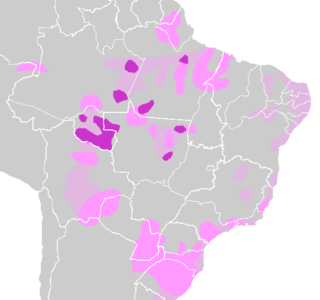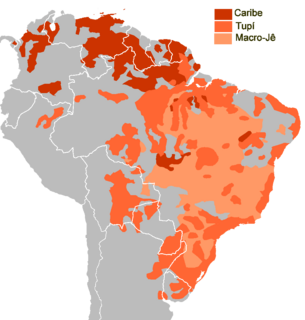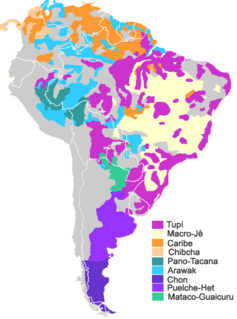Related Research Articles

The Tupi or Tupian language family comprises some 70 languages spoken in South America, of which the best known are Tupi proper and Guarani.

The indigenous Gran Chaco people consist of approximately thirty-five tribal groups in the Gran Chaco of South America. Because, like the Great Plains of North America, the terrain lent itself to a nomadic lifestyle, there is little to no archaeological evidence of their prehistoric occupation. Contributing to this near-absence of archaeological data is the lack of suitable raw material for stone tools or permanent construction and soil conditions that are not conducive to the preservation of organic material.

Je–Tupi–Carib is a proposed language family composed of the Macro-Je, Tupian and Cariban languages of South America. Aryon Rodrigues (2000) based this proposal on shared morphological patterns. In an earlier proposal, Rodrigues (1985) had also proposed a Tupí-Cariban language family.
The Tupí or Tupinambá languages are a subgroup of the Tupi–Guarani language family.

Macro-Jê is a medium-sized language stock in South America, mostly in Brazil but also in the Chiquitanía region in Santa Cruz, Bolivia, as well as (formerly) in small parts of Argentina and Paraguay. It is centered on the Jê language family, with most other branches currently being single languages due to recent extinctions.

The Borôroan languages of Brazil are Borôro and the extinct Umotína and Otuke. They are sometimes considered to form part of the proposed Macro-Jê language family, though this has been disputed.
Guaicuruan is a language family spoken in northern Argentina, western Paraguay, and Brazil. The speakers of the languages are often collectively called the Guaycuru peoples. For the most part, the Guaycuruans lived in the Gran Chaco and were nomadic and warlike, until finally subdued by the various countries of the region in the 19th century.

Mataguayo–Guaicuru, Mataco–Guaicuru or Macro-Waikurúan is a proposed language family consisting of the Mataguayan and Guaicuruan languages. Pedro Viegas Barros claims to have demonstrated it. These languages are spoken in Argentina, Brazil, Paraguay, and Bolivia.

Spanish is the language that is predominantly understood and spoken as a first, or second language by nearly all of the population of the Argentina. According to the latest estimations, the population is currently greater than 45 million.

The Xingu Indigenous Park is an indigenous territory of Brazil, first created in 1961 as a national park in the state of Mato Grosso, Brazil. Its official purposes are to protect the environment and the several tribes of Xingu indigenous peoples in the area.

The Charruan languages are a group of languages once spoken in Uruguay and the Argentine province of Entre Ríos. In 2005, a semi-speaker of the Chaná language, Blas Wilfredo Omar Jaime, was found in Entre Ríos Province, Argentina.
Trumai is an endangered language isolate of Brazil. Most Trumai are fluent in languages of wider communication, and children are not learning it well.
Taruma (Taruamá) is a divergent language of northeastern Brazil. It has been reported to be extinct several times since as far back as 1770, but Eithne Carlin discovered the last speakers living among the Wapishana, and is documenting the language. It would seem that "Saluma" is the same language.

The indigenous languages of the Americas form various linguistic areas or Sprachbunds that share various common (areal) traits.
Proto-Tupian (PT) is the reconstructed common ancestor of all the Tupian languages. It consists, therefore, of a hypothetical language, reconstructed by the comparative method from data of the descendant languages.

The indigenous languages of South America are those whose origin dates back to the pre-Columbian era. The subcontinent has great linguistic diversity, but, as the number of speakers of indigenous languages is diminishing, it is estimated that it could become one of the least linguistically diverse regions of the planet.
The Guaráyu or Guaráyo languages the are a subgroup of the Tupi–Guarani language family.
The Tenetehára or Teneteharan languages are a subgroup of the Tupi–Guarani language family.
The Xingu languages are a subgroup of the Tupi–Guarani language family.
References
- 1 2 3 Campbell, Lyle; Grondona, Verónica (2012). "Languages of the Chaco and Southern Cone". In Grondona, Verónica; Campbell, Lyle (eds.). The Indigenous Languages of South America. The World of Linguistics. 2. Berlin: De Gruyter Mouton. pp. 625–668. ISBN 9783110255133.
- 1 2 Jolkesky, Marcelo Pinho de Valhery (2016). Estudo arqueo-ecolinguístico das terras tropicais sul-americanas (Ph.D. dissertation) (2 ed.). Brasília: University of Brasília.
- ↑ Villas Bôas, O.; Villas Bôas, C. (1970). Xingu: Os Índios, Seus Mitos. São Paulo: Círculo do livro S.A.
- ↑ Nikulin, Andrey V. 2019. The classification of the languages of the South American Lowlands: State-of-the-art and challenges / Классификация языков востока Южной Америки . Illič-Svityč (Nostratic) Seminar / Ностратический семинар, Higher School of Economics, October 17, 2019.